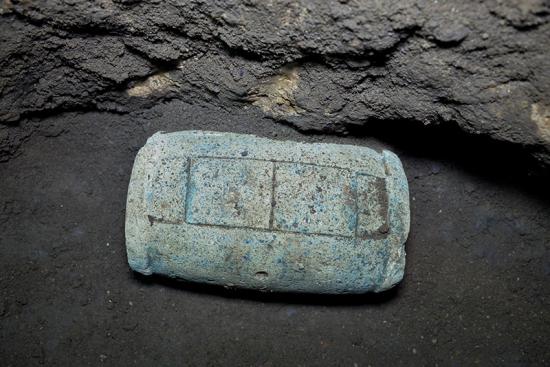Skeleton found in cistern, along with infant that showed signs of being cooked
Source -
http://mexiconewsdaily.com/news/evidence-of-pulque-god-found-in-tlaxcala/
HALLAN ENTIERRO DE PERSONAJE VINCULADO CON OMETOCHTLI, DIOS DEL PULQUE, EN TLAXCALA
INAH
Source - http://www.inah.gob.mx/es/boletines/4933-hallan-entierro-de-personaje-vinculado-con-ometochtli-dios-del-pulque-en-tlaxcala
 Los restos óseos se encontraron en un aljibe de la Zona Arqueológica de Zultépec-Tecoaque con una ofrenda de piezas de cerámica, fragmentos de huesos de niños y figurillas. Foto Melitón Tapia, INAH.
Los restos óseos se encontraron en un aljibe de la Zona Arqueológica de Zultépec-Tecoaque con una ofrenda de piezas de cerámica, fragmentos de huesos de niños y figurillas. Foto Melitón Tapia, INAH.
The Zultépec-Tecoaque archaeological site in Tlaxcala, an active dig for almost 25 years, keeps surprising archaeologists with its formerly hidden secrets and treasures, offering a unique glimpse into the life and times of the people of the region — the Acolhua — immediately before the Spanish conquest.
Just last Wednesday, a surprising and special discovery was made: the skeleton of a high-ranking Acolhua citizen buried in a cistern, along with countless significant objects.
 En un aljibe de la Zona Arqueológica de Zultépec-Tecoaque, especialistas del INAH encontraron el entierro de un personaje vinculado con Ometochtli, deidad del pulque. Foto Melitón, Tapia INAH.
En un aljibe de la Zona Arqueológica de Zultépec-Tecoaque, especialistas del INAH encontraron el entierro de un personaje vinculado con Ometochtli, deidad del pulque. Foto Melitón, Tapia INAH.
Archaeologists also found a full-size throne built of tezontle, a volcanic rock used widely in construction and ornamentation in pre-hispanic and colonial Mexico, and a “spectacular” cylindrical carved stone that displays the glyph, or pictograph, of the Aztec god Ometochtli, or “Two Rabbit.”
 En la ofrenda, sobresalen una pieza cilíndrica y un trono de piedra que tienen grabado el numeral “dos conejo”. Foto Melitón Tapia INAH.
En la ofrenda, sobresalen una pieza cilíndrica y un trono de piedra que tienen grabado el numeral “dos conejo”. Foto Melitón Tapia INAH.
The finding is puzzling for specialists due to its location 100 meters away from the ceremonial center in a residential area of the small town, which was inhabited between 1200 and 1521 BC. Traditionally, prominent citizens have been found buried in what were considered at the time to be sacred places.
“The Acolhua used these kinds of cisterns, 130 centimeters in diameter, for rainwater storage as other sources of water were scarce,” said archaeologist Enrique Martínez Vargas, director of the Zultepec-Tecoaque project. “To date we’ve dug 13 cisterns, but this is the first time we have found such an important figure buried in one of them. This particular character was identified with the Ometochtli glyph, associated with the pulque and drunkenness deity, represented by a rabbit.
“It should be noted that this zone was renowned for its high production of pulque [an alcoholic beverage made from the fermented sap of the maguey plant]. Ometochtli is one of the 400 rabbit-gods, but in the area we had only found Mayahuel, the deity of maguey.”
Now, he said, “We have managed to locate evidence of a pulque god.”
The person buried in the cistern was a 25-year-old, 1.6-meter-tall male, and studies will enable specialists to learn more about him, particularly the cause of death.
It “is the most important public figure unearthed in the zone,” said Martínez, adding that “this discovery modifies our conception of these kinds of burials in pre-hispanic Mexico.”
Other objects, such as pulque carafes, have been found inside what specialists have begun calling the “funerary cistern,” but none as disconcerting as the vertebrae and ribs “of at least three different infants, one of them with clear signs of being cooked or boiled, and possibly consumed,” said archaeologist Bertha Flores.
Flores said they can’t be 100% certain that the infant “was a victim of cannibalism in this particular town, as the remains could have been brought from some other place. We’ll be able to determine this after analyzing the bones.”
Since the first excavations in 1992, the Zultépec-Tecoaque zone has offered priceless remains, such as the recently discovered evidence of 550 Spanish conquistadors and their African and American slaves, imprisoned and sacrificed in that town.